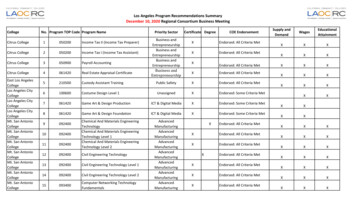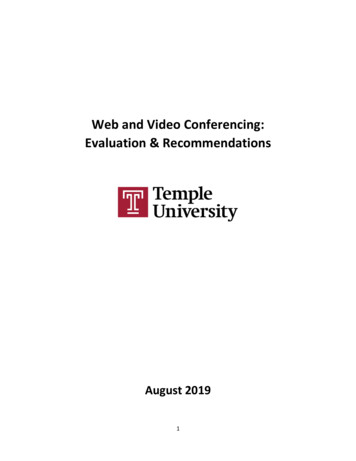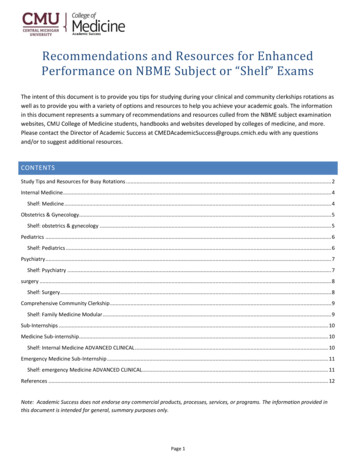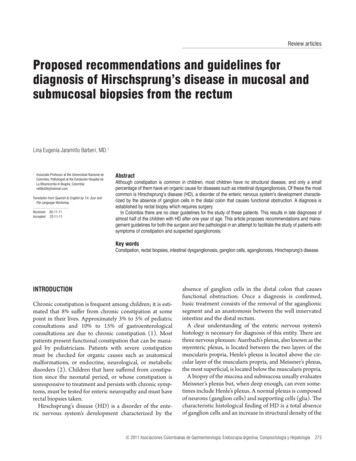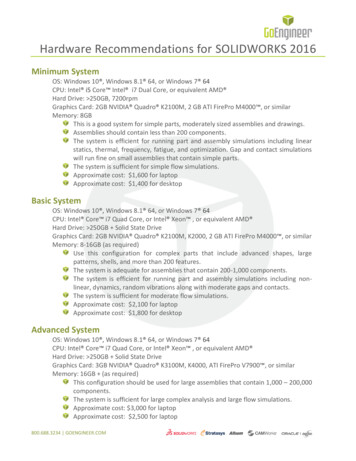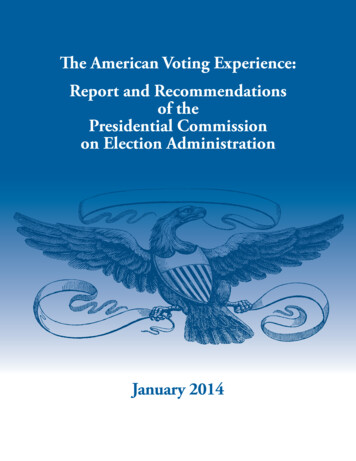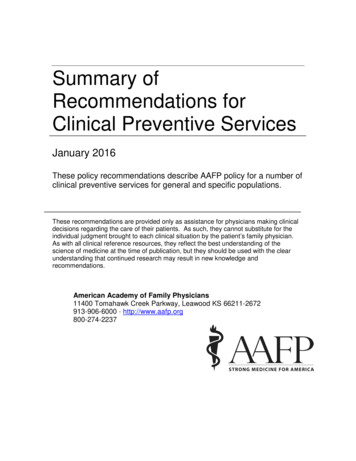
Transcription
Summary ofRecommendations forClinical Preventive ServicesJanuary 2016These policy recommendations describe AAFP policy for a number ofclinical preventive services for general and specific populations.These recommendations are provided only as assistance for physicians making clinicaldecisions regarding the care of their patients. As such, they cannot substitute for theindividual judgment brought to each clinical situation by the patient’s family physician.As with all clinical reference resources, they reflect the best understanding of thescience of medicine at the time of publication, but they should be used with the clearunderstanding that continued research may result in new knowledge andrecommendations.American Academy of Family Physicians11400 Tomahawk Creek Parkway, Leawood KS 66211-2672913-906-6000 · http://www.aafp.org800-274-2237
Introduction toAAFP Summary of RecommendationsFor Clinical Preventive ServicesC Recommendation: The AAFP recommendsagainst routinely providing the service. There maybe considerations that support providing the servicein an individual patient. There is at least moderatecertainty that the net benefit is small.D Recommendation: The AAFP recommendsagainst the service. There is moderate or highcertainty that the service has no net benefit or thatthe harms outweigh the benefits.I Recommendation: The AAFP concludes thatthe current evidence is insufficient to assess thebalance of benefits and harms of the service.Evidence is lacking, of poor quality, or conflicting,and the balance of benefits and harms cannot bedetermined.I-HBHealthy Behavior is identified as desirablebut the effectiveness of physician’s advice andcounseling is uncertain.The AAFP Summary of Recommendations forClinical Preventive Services (RCPS) is a documentthat is periodically updated through the work of theAAFP’s Commission on Health of the Public andScience (CHPS) and is approved by the AAFPBoard of Directors. The starting point for therecommendations is the rigorous analysis ofscientific knowledge available as presented by theUnited States Preventive Services Task orce.org/The USPSTF conducts impartial assessments ofthe scientific evidence for the effectiveness of abroad range of clinical preventive services,including screening, counseling, and preventivemedications.The CHPS reviews recommendations released bythe USPSTF and makes recommendations to theAAFP Board of Directors. In most cases the AAFPagrees with the USPSTF, however, there arecircumstances where there are differences.The AAFP grading system for thoserecommendations before May 2007 includes:SR Strongly Recommend: Good quality evidenceexists which demonstrates substantial net benefitover harm; the intervention is perceived to be costeffective and acceptable to nearly all patients.R Recommend: Although evidence exists whichdemonstrates net benefit, either the benefit is onlymoderate in magnitude or the evidence supportinga substantial benefit is only fair. The intervention isperceived to be cost effective and acceptable tomost patients.NR No Recommendation Either For or Against:Either good or fair evidence exist of at least a smallnet benefit. Cost-effectiveness may not be knownor patients may be divided about acceptability ofthe intervention.RA Recommend Against: Good or fair evidencewhich demonstrates no net benefit over harm.IInsufficient Evidence to Recommend Eitherfor or Against: No evidence of even fair qualityexists or the existing evidence is conflicting.I-HBHealthy Behavior is identified as desirablebut the effectiveness of physician’s advice andcounseling is uncertain.In 2007, the USPSTF changed the grading ofevidence for new recommendations g/uspstf/grades.htm). Therefore, the AAFP has alsochanged its grading of the evidence to be moreconsistent with the USPSTF. The USPSTF andAAFP are in a transition period and areimplementing the use of two different gradingsystems for the recommendations. The firstgrading system applies to the recommendationsthat occurred before May 2007, and the secondgrading system applies to recommendations thatoccurred during or after May 2007. These gradingsystems are outlined below.The AAFP grading systems for therecommendations that occur during or afterMay 2007 includes:A Recommendation: The AAFP recommends theservice. There is high certainty that the net benefitis substantial.B Recommendation: The AAFP recommendsthe service. There is high certainty that the netbenefit is moderate or there is moderate certaintythat the net benefit is moderate to substantial.AAFP Policy Action November 1996,January 2016 · Order No. 1968Where appropriate, specific website URL’s areprovided which link directly to the clinicalconsideration section of the U.S. Preventive2
Services Task Force. The clinical considerationsection provides additional information needed tointerpret and implement the recommendations.Physicians are encouraged to review not only theneeds of individual patients they see, but also ofthe populations in the communities they serve todetermine which specific populationrecommendations need to be implementedsystematically in their practices. Therecommendations contained in this document arefor screening, chemoprophylaxis and counselingonly. They do not necessarily apply to patients whohave signs and/or symptoms relating to a particularcondition.These recommendations are provided only asassistance for physicians making clinical decisionsregarding the care of their patients. As such, theycannot substitute for the individual judgmentbrought to each clinical situation by the patient’sfamily physician. As with all clinical referenceresources, they reflect the best understanding ofthe science of medicine at the time of publication,but they should be used with the clearunderstanding that continued research may resultin new knowledge and recommendations. Theserecommendations are only one element in thecomplex process of improving the health ofAmerica. To be effective, the recommendationsmust be implemented.AAFP Recommendations for Genetic andGenomic TestsThe AAFP Recommendations for Geneticand Genomic Tests is provided to aidmembers their delivery of evidence-basedpractices to their patients. Theserecommendations are updated periodicallythrough the work of the AAFP’s Commissionon Health of the Public and Science (CHPS)and are approved by the AAFP Board ofDirectors. The starting point for therecommendations is the rigorous analysis ofthe scientific outcomes available aspresented by the Evaluation of Genomics inPractice and Prevention Working Group(EGAPP WG).http://www.egappreviews.org/workingrp.htmThe CHPS reviews recommendationsreleased by the EGAPP WG and makesrecommendations to the AAFP Board ofDirectors. The AAFP agrees with the EGAPPWG in their recommendations wheneverpossible; however, there may beAAFP Policy Action November 1996,January 2016 · Order No. 1968circumstances that could warrant differentrecommendations.The AAFP uses language consistent with thelanguage in the recommendations from theEGAPP WG. The language is as follows:Recommend for: The AAFP recommendsthe test. There is evidence to support that themagnitude of the effect of the test issubstantial, moderate or small (as opposed tozero benefit).Recommend against: The AAFPrecommends against the test. There isevidence to support that the magnitude of theeffect of the test is zero or that there are netharms.Insufficient: The AAFP concludes that thecurrent evidence is insufficient to assess thebalance of benefits and harms of the test.Where appropriate, specific website URL’sare provided which link directly to the clinicalconsideration section of the EGAPP WG.This section provides additional informationfor interpreting and implementing therecommendation.These recommendations are provided onlyas assistance for physicians making clinicaldecisions regarding the care of their patients.As such, they cannot substitute for theindividual judgment brought to each clinicalsituation by the patient’s family physician. Aswith all clinical reference resources, theyreflect the best understanding of the scienceof medicine at the time of publication, butthey should be used with the clearunderstanding that continued research mayresult in new knowledge andrecommendations. These recommendationsare only one element in the complex processof improving the health of America. To beeffective, the recommendations must beimplemented.3
American Academy of Family PhysiciansSummary of Recommendations for Clinical Preventive ServicesAbdominal Aortic Aneurysm, MenThe AAFP recommends one-time screening for abdominal aortic aneurysm (AAA) by ultrasonography inmen ages 65 to 75 years who have ever smoked. (2014)(Grade: B recommendation)(Grade Definition: f/grades.htm )(Clinical ider)The AAFP recommends that clinicians selectively offer screening for AAA in men ages 65 to 75 years whohave never smoked rather than routinely screening all men in this group. (2014)(Grade: C recommendation)(Grade Definition: f/grades.htm)(Clinical ider)Abdominal Aortic Aneurysm, WomenThe AAFP concludes that the current evidence is insufficient to assess the balance of benefits and harmsof screening for AAA in women ages 65 to 75 years who have ever smoked. (2014)(Grade: I recommendation)(Grade Definition: f/grades.htm )(Clinical ider)The AAFP recommends against routine screening for AAA in women who have never smoked. (2014)(Grade: D recommendation)(Grade Definition: f/grades.htm )(Clinical ider )Abuse, Intimate Partner Violence of Elderlyand Vulnerable AdultsAlcohol Misuse, AdultsAlcohol Misuse, AdolescentsBacteriuria, Asymptomatic, PregnantWomenBacteriuria, Asymptomatic, Men, NonPregnantAAFP Policy Action November 1996,January 2016· Order No. 1968The AAFP recommends that clinicians screen women of childbearing age for intimate partner violence(IPV), such as domestic violence, and provide or refer women who screen positive to interventionservices. This recommendation applies to women who do not have signs or symptoms of abuse. (2013)(Grade: B recommendation)(Grade Definition: rec2.htm)(Clinical Considerations: f12/ipvelderfinalrs.htm)The AAFP concludes that the current evidence is insufficient to assess the balance of benefits and harmsof screening all elderly and vulnerable adults (physically or mentally dysfunctional) for abuse and neglect.(2013)(Grade: I statement)(Grade Definition: rec2.htm)(Clinical Considerations: f12/ipvelderfinalrs.htm)The AAFP recommends that clinicians screen adults aged 18 years or older for alcohol misuse andprovide persons engaged in risky or hazardous drinking with brief behavioral counseling interventions toreduce alcohol misuse. (2013)(Grade: B recommendation)(Grade Definition: f/grades.htm#post)(Clinical consider )The AAFP recognizes the avoidance of alcohol products by adolescents aged 12 to 17 years is desirable.The effectiveness of the physician's advice and counseling in this area is uncertain. (2013)(Grade: I recommendation)(Grade Definition: f/grades.htm#post)(Clinical consider)The AAFP recommends screening for asymptomatic bacteriuria with urine culture for pregnant women at12 to 16 weeks’ gestation or at the first prenatal visit, if later. (2008)(Grade: A recommendation)(Grade Definition: f/grades.htm#post)(Clinical Consideration: tm#clinical )The AAFP recommends against screening for asymptomatic bacteriuria in men and nonpregnant women.(2008)(Grade: D recommendation)(Grade Definition: f/grades.htm#post)(Clinical Consideration: inical )4
American Academy of Family PhysiciansSummary of Recommendations for Clinical Preventive ServicesBacterial Vaginosis, Pregnant WomenThe AAFP recommends against screening for bacterial vaginosis in asymptomatic pregnant women at low riskfor preterm delivery. (2008)(Grade: D recommendation)(Grade Definition: f/grades.htm#post)(Clinical Considerations: inical )The AAFP concludes that the current evidence is insufficient to assess the balance of benefits and harms ofscreening for bacterial vaginosis in asymptomatic pregnant women at high risk for preterm delivery. (2008)(Grade: I recommendation)(Grade Definition: f/grades.htm#post)(Clinical Considerations: inical )Behavior Counseling, Healthful Diet andThe AAFP recommends offering or referring adults who are overweight or obese and have additionalPhysical Activity for Cardiovascular Disease cardiovascular disease (CVD) risk factors to
AAFP Policy Action November 1996, 2 January 2016 · Order No. 1968 Introduction to . AAFP Summary of Recommendations . For Clinical Preventive Services. The AAFP Summary of Recommendations for Clinical Preventive Services (RCPS) is a document that is periodically updated through the work of the AAFP’s Commission on Health of the Public and
